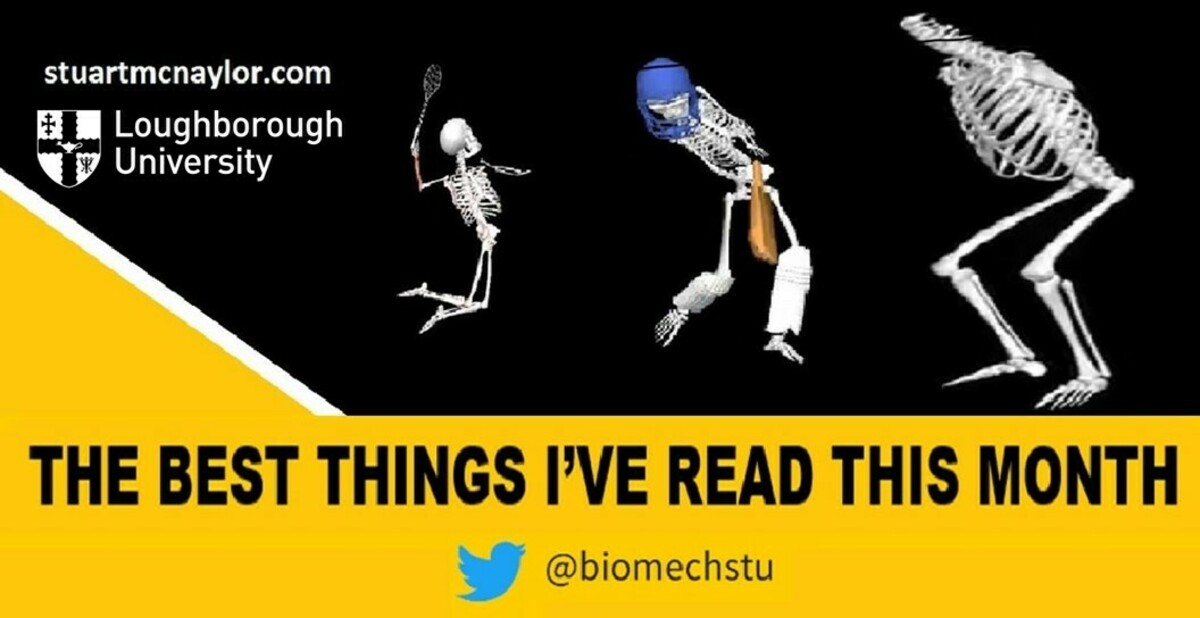
Here’s what I would like to share with you this month…
There are two sections: ‘What Have I Been Up To?’ and ‘What Have I Been Reading?’
What Have I Been Up To?
“My life with pose estimation”: Scott Selbie presented a lecture for my YouTube channel on the past, present, and future of pose estimation within motion capture. Scott covered marker-based and markerless motion capture, evaluation and validation, anatomical reference frames, soft tissue artefact, tracking, and more. I hope you’ll find this as insightful and entertaining as I did:
Jump and sprint momentum: I went on ‘The Research Beat’ podcast to discuss our recent data simulation paper on factors affecting the relationship between jump momentum and sprint momentum.
Online platforms: I’ve given a few presentations recently on topics relating to personal branding and effective use of online platforms within academia. I’ve really enjoyed talking exploring this side of things a bit more and sharing my experiences. This has included a version of my social media presentation for a group at the University of Oxford, a discussion on using YouTube for academia with ‘Science in the Break’, and a workshop for the BASES Biomechanics Interest Group on building a personal brand. The BASES presentation should be available for members on their website soon, and I’ll soon record an adapted open version based on feedback and discussions after the event.
PhD studentships for BAME students: School-funded PhD studentships have been ring-fenced for UK applicants who identify as being from a BAME background. See further details and please get in touch if you want to discuss possible biomechanics projects.
What Have I Been Reading?
Now for the main part of the newsletter…
Legacy of A.V. Hill: It is 100 years since A.V. Hill was jointly awarded the 1922 Nobel Prize for Physiology or Medicine for his work on energetic aspects of muscle contraction. This article explores the legacy of his work and how it continues to influence our thinking within biomechanics and physiology.
Motor synergies: What is a synergy? What is the historical background to the concept? How is dynamic stability achieved? How does training affect synergies? And what are the unresolved issues? This review article by Mark Latash outlines and evaluates the literature on motor and non-motor synergies, covering these topics and more.
Wearable sensors and injury: Many claims are made about the efficacy of various wearable technologies for preventing, assessing, and informing recovery from sport-related musculoskeletal injuries. But what does the literature actually say? This review by Ezio Preatoni and colleagues evaluates 165 articles within the literature to inform guidelines and good practices for future research and dissemination.
An ecological-dynamical approach: Paul Glazier’s latest article applies aspects of ecological psychology and dynamical systems theory to a golf example to demonstrate how the various subdisciplines of sport science can contribute to performance. Implications for biomechanics, coaching, and equipment design are all dicussed.
Gender diversity in sport science: Jo Clubb’s blog post provides practical tips to help promote gender diversity in sports. Alongside the 14 recommendations for sports teams and practitioners were many links to additional resources and guides.
Public speaking: As we approach conference season and a first in-person presentation in a few years (or first ever) for many, I found this newsletter issue by Sahil Bloom particularly useful. He provides a series of 12 tips for public speaking, ranging from pacing and structure through to playing ‘the lava game’ (your pockets and torso are “lava” - don’t touch them!).
Excel tips via TikTok: During one of our informal teaching discussions for ISBS, I was introduced to the videos of ‘Miss Excel’ (thank you). You know all of those repetitive tasks you do in Excel? Well, this is the way to learn the tips and tricks to automate everything instead via entertaining short videos. Ideal for teaching, too.
Thank You
That’s all for this month. If you found it useful, please forward this email or share this link with friends, colleagues, or on social media.
What Have You Read Recently?
If you’ve read anything particularly interesting or useful recently, please reply to this email and let me know. I read all of the replies and I’m always looking for good reading suggestions.
Take care, and thank you for reading. I hope you have a great June!
Stuart